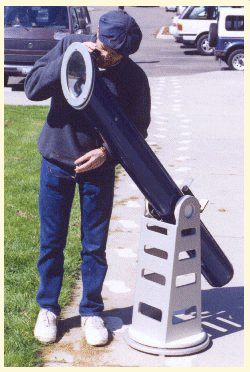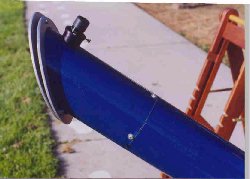David North looks
through the author's Sun Scope
Key Materials:
Partially aluminized parallel-plate glass (5% transmission). A "one way" mirror also works fine; the stuff, in other words, commonly used in casinos and department stores.
Be sure to mount the aluminized surface inside (toward the primary).An unaluminized primary. Keep it small, 4.5" or 6" works just fine. Keep it "slow" F/8 or F/10.
Sonotube. With a Sun Scope, we do not have to worry about "tube currents" and have our tube 2" larger in diameter than our primary--if you can fit your primary inside the tube, it will work fine.
Sky and Telescope, August '89 p.207ff. Sidewalk Astronomer Tom Mathews' article which inspired me.
The Dobsonian Sun Telescope
At left is an example of another contribution to amateur astronomy by John Dobson: an extremely safe Sun telescope.
One immediately notices the mirror tilted at 45-degrees at the front of the tube... This is actually a piece of one-way mirror, which serves two purposes: One, to deflect up to 95% of the incoming sunlight, thereby acting as a filter, and, two, to act like a normal diagonal mirror: to bounce the light gathered by the unaluminized primary out the side of the tube to be magnified by a suitable eyepiece--but not before this light passes through a welders' glass to filter out any harmful infrared or ultraviolet radiation.
Designed into this failsafe method to view the Sun, is this: If the front mirror is broken, or becomes accidentally dislodged, the viewer will be protected since no direct sunlight will reach the eyepiece; the eyepiece will, in fact, be pointed safely at the ground!
Construction Tips
Note that I have cut the telescope tube in half about 12" from the focuser--this is necessary since I glued (with 100% Silicone glue) the one-way mirror directly on the cardboard sonotube; it is necessary, that is, so I can mount, or de-mount, the focuser or welders' glass which is glued to the bottom of it. (Line--glue-- the inside of one half of the tube with "sleeve material,"--cardboard tube in which you have cut a section out, or other appropriately thin material).The focuser I use here is a "2-inch to 1-1/4-inch adapter"--a $20 item available from telescope outfits like Lumicon or Orion. It is low and sturdy; and provides a flat bottom in which to glue the welders' glass. You will need to experiment with the grade of welders' glass you will need, by the way. My 6-incher requires a "grade seven," I believe. I would also recommend the "gold anodized" version of welders' glass over the traditional green glass--to yield a more natural, yellowish, transmission of light.
You must cut the front of the tube at exactly 45-degrees, if you glue the front mirror directly on the cardboard as I did. Tape enough 8-1/2" X 11" paper together end to end to go around your tube. Cut both ends at 45-degrees, making a trapezoidal shape. Bring the two ends together so that one edge of the paper is snug against the tube (some trimming will be required). Trace a line; cut to it.
With all that weight up front, you will have to make a tall rocker box, or use weight at the rear of your tube (I did both).
What will you see? Sunspots, faculae, granulation!

